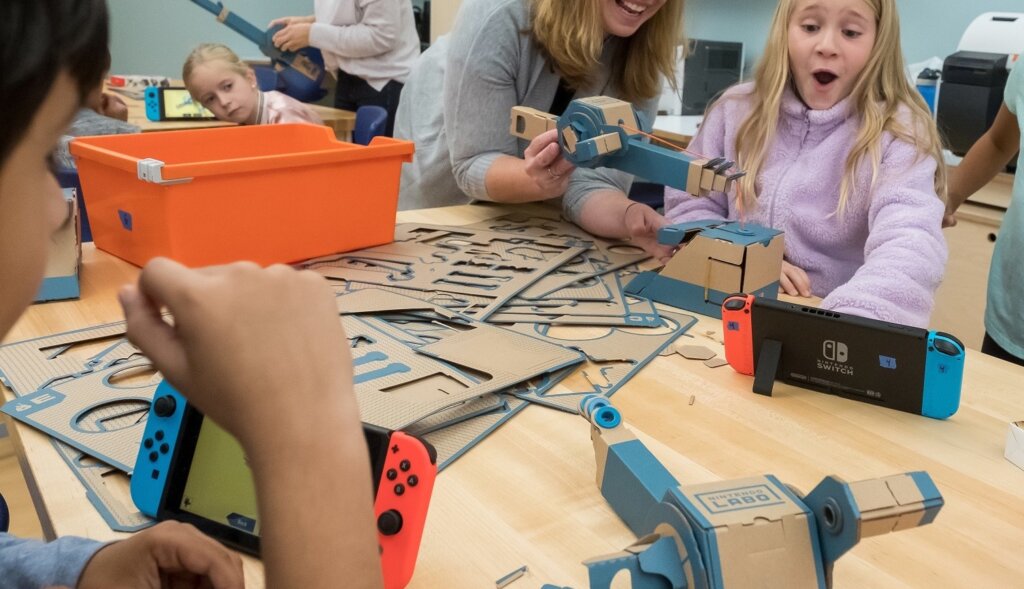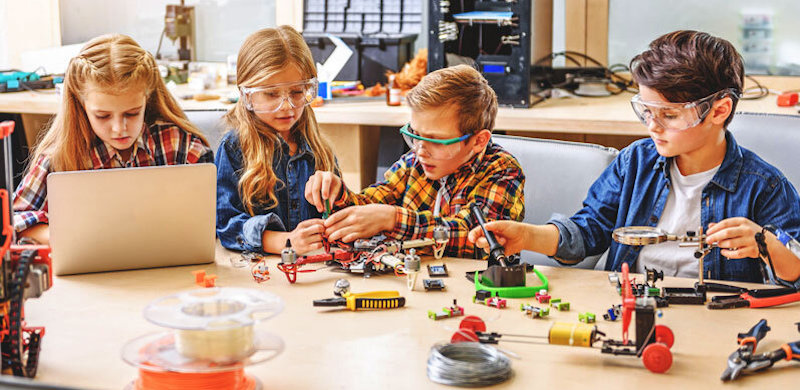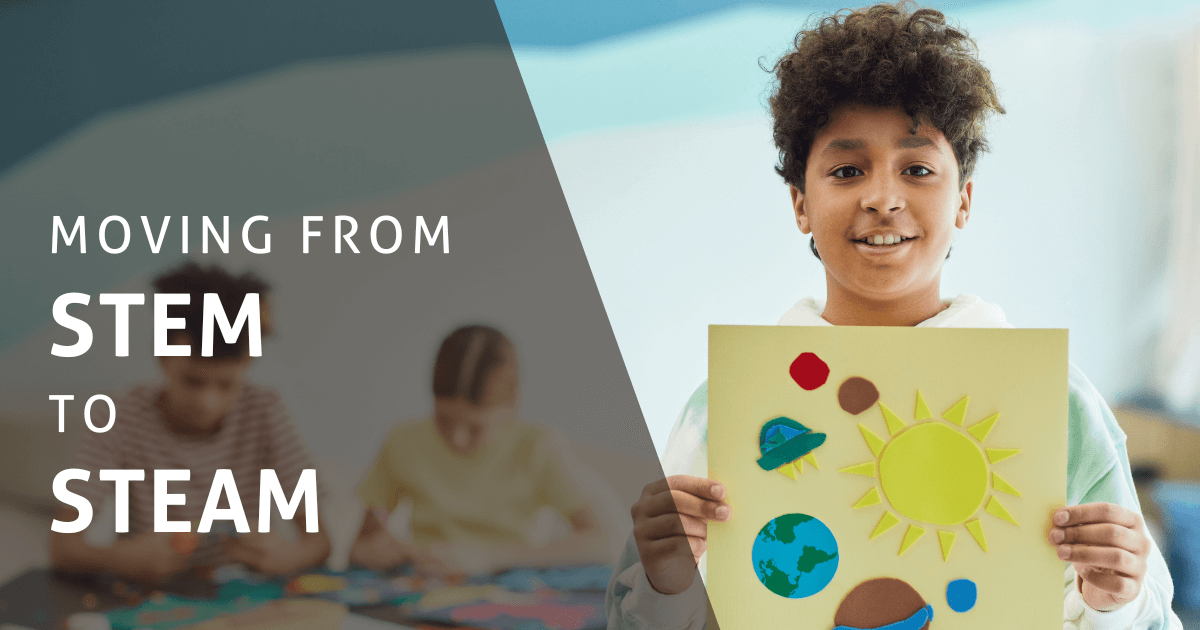After STEM education was popularized in the early 21st century, some educators thought it was missing something. Did STEM differentiate too much between the sciences and the arts? Did too much emphasis on STEM education cause students to miss out on developing artistic skills? In the mid 2010s, the 'STEAM' acronym began to rise in popularity. Although both STEM and STEAM learning are each great experiences for students, STEAM provides more opportunities for students to develop both hard and soft real-world skills. And, when moving from STEM to STEAM, students have the chance to display their knowledge using techniques that may be more suited to their skills and interests.
Adding an 'A' to STEM Learning
As evidenced with countless school STEM clubs, programs, and district-wide initiatives, STEM education continues to be a prominent part of preparing today's students. Knowing how the world and economy have evolved over the last couple decades leads a lot of educators and parents to relentlessly push students toward STEM opportunities. While STEM careers are certainly plentiful (and often fruitful), we recognize they're not for everyone. Moving from STEM to STEAM allows students to keep their options open while developing skills they'll need in any industry, from the sciences to the creative arts. STEAM education allows students to incorporate artistic design, problem-solving, and creativity in hands-on projects, abilities that translate into many future fields. Plus, in incorporating artistic elements, they can quickly discover a new sense of creativity.
Starting with STEM as a base.
Many times, STEM projects and challenges spark student interest in a particular subject. From there, educators can introduce students to STEAM approaches as a way to get even more creative. This initial transition may seem daunting, but most teachers have already laid the groundwork for adding the 'A.' If you've ever had your class make a model of the solar system or solve a word problem, for example, you're already halfway there! Fully transitioning to STEAM just means being more intentional about incorporating the arts and sciences together.
Coding education is a perfect example. Coding is, of course, a great STEM skill for students to have, but to make coding into a STEAM opportunity, you'll have to think outside the box. Rather than just coding a fully digital game, maybe your students can craft a robot powered with a micro:bit "brain"! Or maybe they'll use Makey Makey to write code for a cardboard guitar. These experiences show students how thinking about problems like an artist can help them arrive at more practical, more interesting—and ultimately more successful—solutions.
Shifting to a STEAM mindset.
Going from STEM to STEAM isn't just about integrating the arts where convenient. It's about encouraging students to think critically using all of the tools available to them, no matter the discipline. Like STEM, STEAM allows students to come to a conclusion based on their own experimentation and discovery. However, STEAM builds on the STEM process by channeling student inquiry through creative design. Instead of trying to teach students STEAM skills separately, learning experiences have evolved to involve a coordinated approach. In STEAM, students are challenged to use a variety of skills to generate creative solutions. This method also gives students the freedom to add a personal touch of creativity. For STEAM projects, adding creative, aesthetically pleasing elements can amplify the results and increase student engagement.
An interdisciplinary approach.
Many students form the impression that they're good at either science or art, but not both. Of course, this isn't true! They might just need help understanding how the two disciplines can wonderfully complement each other. STEAM education illuminates the many links between the sciences and the arts. Understanding the design process, for example, is one solid connection between the two. Each component of an object must have been designed, prototyped, created, and perfected—all steps that involve artistry and creativity along the way. Take the lamp on your desk. Its height, color, and embellishments all required deep thought from designers. At the same time, the lamp wouldn't function without scientific inventions like electricity and lightbulbs! Drawing these connections between STEAM principles helps students see the value of interdisciplinary learning and allows them to develop a well-rounded mindset.

How creativity affects STEAM.
The creative process of STEAM learning is absolutely vital. Some might even argue that it's more important than the eventual outcomes. In STEM learning, there are often only a few "correct" ways to solve a problem. STEAM, however, is more about applying imagination and creativity, which might lead to realizations that weren't even on the radar. It's still hands-on learning—just with some added artistic elements included. Whether it's creating art, music, writing, or multimedia projects, leaning on STEAM helps students develop the knack for using creativity.
Using STEAM beyond the classroom.
The skills students learn through STEAM are applicable far beyond the classroom. The first place students might take their new skills is right down the hall to the school makerspace. In fact, makerspaces epitomize the ideals of STEAM, drawing together creativity and science in unique ways. But STEAM skills serve students into the future as well, helping them remain employable in an ever-changing economy. Employees who are proficient in computer programming are now numerous, but not everyone can approach problems with an open mind and from a fresh perspective. STEAM learning develops not only the hard skills necessary for future careers but also something even more valuable: the ability to adapt.

Benefits of STEAM Education
With STEAM education, new instructional methods have emerged that focus on the more artistic side of education, helping students develop skills for both academic and personal success. We're talking about key skills like creativity, collaboration, and even confidence. And, sooner or later, kids will apply these principles in all of their experiences—whether that's in or out of the classroom. Incorporating STEAM ideas can create key benefits for children in other areas, too. For example, kids could bolster both their literacy and math skills simultaneously through a STEAM-focused class. STEAM can also make any classroom more inclusive. Students on the shyer side, for example, might feel more comfortable expressing their ideas or taking risks in this new kind of environment. Not only does STEAM meet more of the needs today's students have, but it also prepares them for all they could encounter in a 21st-century career.
Moving past STEM into STEAM.
The skills students learn from STEAM experiences can be directly applied in their future endeavors. Best of all, STEAM still involves students using technology. This enables them to continue building tech knowledge and proficiencies while they try solving tasks from different angles. There are also various technologies that specifically challenge kids to think creatively. These include art and design tools, which students can use to showcase their new knowledge through creative projects. Also, in STEAM learning, making use of multiple instructional styles can be helpful. Besides reading and hands-on making, teachers can try sharing media with students, posing open-ended questions, or even try performances. Each of these strategies can help students build STEAM skills that will get them ready for anything.
For the latest EdTech, STEM, and 21st century education news, follow us on Twitter and Instagram. Like us on Facebook, too, or sign up for our newsletter for our latest product announcements and offerings. If you have an idea for an Eduporium Weekly theme, send us a message on social media or comment below.




Loved how you’ve laid out the transition from STEM to STEAM — it clearly highlights why integrating the arts enhances creativity, critical thinking, and student engagement. The example of students applying design thinking in science projects really struck a chord with me.
As an educator (or enthusiast) who values creative learning, I appreciate seeing practical ways to bring arts into math and science curricula. I’d be curious to learn more about any classroom strategies or resources you recommend for educators just starting to incorporate art into their STEM lessons—especially for those working with limited budgets or in virtual environments.
Thanks for shedding light on this important shift in education! ??